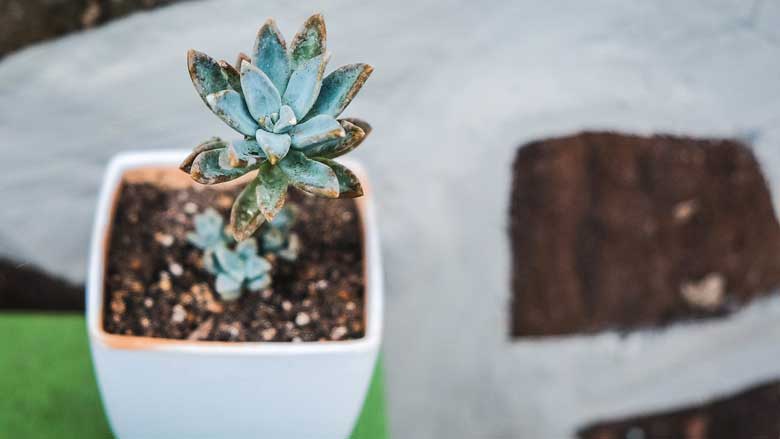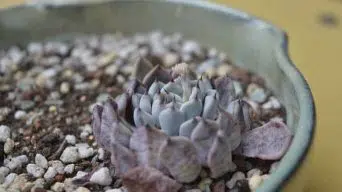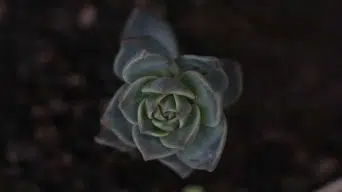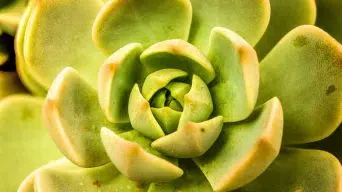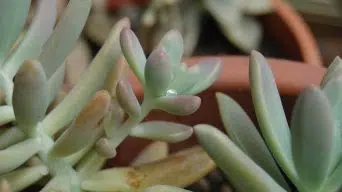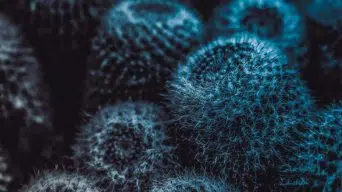Sunburned succulents occur due to excessive sun exposure, leading to wilted, discolored leaves. Treatment involves shade, hydration, and potential pruning, while prevention includes providing proper light and temperature conditions. Identify and address sunburn early to ensure your succulent’s health.
When succulents are exposed to the sun for too long, they can become sunburned.
Sunburn is caused when the plant’s tissue is damaged by overexposure to ultraviolet light (UV) from the sun.
A sunburned succulent has wilted or drooping leaves. They are still crisp but do not return to their original position after being touched.
The succulent will eventually recover. However, the sunburned tissue will never fully heal and may turn brown.
This article will help you identify and treat sunburned succulents while giving prevention tips.
Causes Sunburn on Succulents
Sunburn on succulents is caused by exposure to too much sun and heat.
The burn can be caused by overexposure to UV rays or too much heat from an artificial light source like a grow lamp.
Likewise, sudden changes in temperature or humidity levels around your plant can cause a sunburn.
The most common cause of succulent sunburn is placing them in direct sun for too long.
This can happen by placing them on a windowsill that gets full sun all day or keeping them outside in the hot summer weather when they are not used to it.
Most succulents are sun lovers, which means they love sunlight. This is not a problem as long as your succulent plants get plenty of shade during the hottest hours of the day (usually between 11 am and three pm).
Some succulents are more sensitive than others, so never assume they cannot be burned by too much sun.
Some species may be just as susceptible as any other plant in this regard.
Plants differ in how much sun they need. Some plants, like Aloe Vera, have thick leaves to protect them from the sun.
Other plants might be more sensitive if grown indoors without enough natural light.
Typically, succulents not getting enough shade outdoors during periods of hot weather will be most susceptible.
This includes plants grown too close together and those planted near fences, trees, etc.
Types of Succulents Prone to Sunburn
Some succulent varieties are more prone to sunburn than others.
The most common succulents prone to sunburn are:
1. Haworthia Erythraea ‘Variegata’
This succulent is a close relative to the zebra plant.
One way of identifying sunburned succulents is by their yellowing leaves or crystals on top of it, indicating an issue with the moisture in this succulent.
2. Crassula Ovata (Jade Plant)
Sunburn may be because these plants are very sensitive and don’t like direct sunlight.
They need more indirect light than other succulents do.
It can also look wilted when exposed to too much heat and not enough water.
You’ll notice brown/grey patches where they’ve started dying off from sunlight exposure.
3. Crassula Perforata
This succulent is more likely to sunburn than other members of the Crassula family because it tends to get too hot and does not have enough water.
One way you can identify that it’s been sunburned is if there are brown/grey spots on its leaves, and they feel very crunchy when touched.
4. Aeonium ‘Zwartkop’
These plants are susceptible to sunburn and being too hot, so they’re better off in a shadier location.
They’ll have brown/grey patches that start dying off on their leaves if exposed for too long with insufficient water or sunlight. It will also be wilting again (like the Crassula ovata).
5. Echeveria
These succulents can take more direct light than other species but still need some indirect lighting.
If you notice signs of sunburn, like brown/grey patches, get them out from under the intense sun immediately!
Recognizing Sunburn on Succulents
Succulents will appear sunburned if the plants are exposed to too much direct sunlight. The amount of sunlight they receive plays a crucial role in their health.
The burns typically manifest as brown, yellow, or red blotches on the leaves and stems of a succulent that are in contact with light.
Brown burned areas can be seen on either side of this leaf’s upper edge, where it came into prolonged contact with sunlight.
This discoloration may also occur towards the stem end of succulent leaves, which have been left out all day without protection from shade or humidity.
This results in an unevenly shaped burn mark that frequently appears more prominent than its actual size because they occur on both sides of the leaf’s upper edge, towards its stem end, and around its margins.
Yellow sunburns will appear on succulents that are not in direct contact with the light.
These burns can be seen as mottling and discoloration on plants. It is caused by the leaves being in the sun for a long time and can happen to plants close to fences or other plants.
A succulent leaf can also have a red sunburn towards its stem end, exposed to the sun for a prolonged time.
Common Signs of Sunburn
Common signs of sunburned succulents are:
- Brown spots
- Wilting or leaf loss in the affected area
- Dying leaves
- Leaves with a yellowish tinge
- Yellow sunburns
- Red sunburns towards the leaf’s stem end
- Dry and brittle roots in potting soil
- Damaged or dried soil around the area of sun exposure
If your succulent has any of these symptoms, it is probably sunburned.
The sunburn may be on the stalk or at the base of a succulent leaf.
It is crucial to identify this quickly so you can treat it before it worsens and becomes fatal for your succulent plant!
Succulent Recovery From Sunburn
Once the sunburn has happened, recovery will depend on how severe the damage is.
If the sunburn is light and does not damage the succulent’s leaves or stems, it should be able to recover.
A succulent will usually recover from a light sunburn without any intervention on your part.
The succulent can take a while to recover if the sunburn is more severe.
A succulent with heavy damage will not be able to survive and will need attention to be saved.
Treating Sunburned Succulents
When succulents sunburn, they cannot absorb enough water and nutrients through their leaves.
Treat sunburned succulents by replanting them in a shady spot and spraying the plant with cool water to keep it hydrated.
Consider using shade cloth to provide additional protection from intense sunlight.
If you notice any wilting or drooping leaves, add some mulch around the base of your succulent to help retain moisture.
If the sunburn has not caused any drooping or wilting leaves, you can bring your succulent back into the sun if it is in a shady spot.
Keep an eye on your succulent to ensure it has plenty of water and is shaded by any harsh rays. Once all signs of sunburn have disappeared, you may return your plant to a sunny spot again.
Additionally, ensure your pot drains appropriately because if there is too much standing water, the succulent’s sunburn will worsen.
You can also add an organic fertilizer once a month to ensure your succulent gets all the nutrients it needs.
These plants need to get all of their necessary vitamins and minerals as this will help them begin regrowing healthy new cells again.
Essentially, you want to do anything that relieves this sunburned plant!
Healing Sunburned Succulents: Understanding Degrees of Damage
The first step for healing a sunburnt succulent is identifying what type of sunburn you’re dealing with.
The sunburn symptoms vary depending on what type of sunburn it has (superficial, partial thickness, or deep).
These types can be identified based on how much damage they have received from too many hours in direct sunlight and heat exposure.
1. Superficial Sunburn
A shallow sunburn can be identified as having limited damage with some redness that does not extend into the leaf tissue.
The best way to treat this sunburn type is to remove it from the sun and keep it wet with a spray bottle to reduce transpiration and provide shade.
2. Partial Thickness
Damage that extends into the leaf tissue but not entirely through it. Blistering on some leaves or brown and crispy-looking patches might be caused by sunburned cells.
This sunburn can be treated by cutting off the damaged tissue and providing shade, misting, and time for it to heal.
3. Deep Sunburn
Extreme damage with blistering or burns extending halfway through the succulent leaves.
The best way to treat this sunburn type would be to cut out any burned parts to where you see healthy green tissues growing below.
Then, let your succulents heal for a few weeks in indirect sunlight before putting them back outside once again after all the sunburned tissue has completely healed.
A succulent that gets a sunburn will probably recover. Still, it can take some time for the damaged tissues to heal, and there is always the risk of infection.
You can make healing your succulents easier by following these easy steps:
- Keep your succulents in a shady place.
- Provide plants with adequate water. Keep the soil moist but not soaking wet or bone dry for too long – that will only cause more sunburns, so make sure to keep it moist enough!
- Ensure you have plenty of time before putting them back outside; they need healing before exposure to direct sunlight.
- Avoid watering or fertilizing the burned area, as this can worsen things and cause rot faster.
Preventing Succulent Sunburn
To prevent your succulents from getting sunburned, here are some tips that can help you.
- The best way to prevent a succulent from getting sunburned is by keeping the plant out of direct sunlight, preferably in partial shade, and ensuring it doesn’t get too hot.
- Place your succulent in an area with plenty of natural or artificial bright light but not much heat. A window sill with a curtain can provide filtered sunlight and protection against excessive warmth.
- Succulents like it cool, so you might want to place them near vents if they’re in more intense lighting for long periods.
- Succulents need to be looked at regularly. If they are getting too hot, you can move them to a shadier spot; if they are not getting enough light, you can move them to a sunnier area.
- If your succulent is sunburned, the best way to treat it would be by placing it in a shadier spot.
- If you don’t want to change the location of your succulent, try changing its orientation. Point it away from the sun or turn it so that light hits more of the leaves instead of just one side.
Final Thoughts
Sunburned succulents can be identified, treated, and prevented.
If you know what to look for, there are many tell-tale signs that your plant is sunburnt, like wilted leaves or grayish spots on the tips of leaf margins.
Sunburn should not be a regular occurrence as it leads to small wounds in the skin, disrupting circulation over time. Additionally, sunburned plants will also be sensitive to cold and drought conditions.
The most important thing is to identify the sunburn before it gets worse.
If you notice any of the signs listed above, it is essential to water your succulent and put it in a place with enough light.
Additionally, sunburned plants have a harder time absorbing nutrients from their soil, so fertilizing them can also help.

